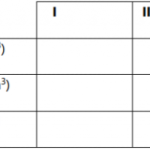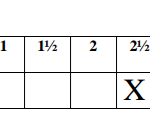KNEC KCSE Chemistry Paper 3 – 2014 Nakuru District Mock
2014 Nakuru District Mock
Chemistry Paper 3
You are provided with
- 10g of solid A which is a mixture of sodium carbonate and sodium chloride.
- 0.2 M HCl solution B
You are required to
- Determine the concentration of sodium carbonate in the mixture.
- Percentage of sodium chloride in the mixture.
Procedure
Transfer the entire solid into a 250 Ml volumetric flask. Add about 100cm3 of distilled water.
Shake to dissolve. Top up with more distilled water to make up to the mark. Label this solution
A2. Using a pipette and a pipette filler, transfer 25 cm3 of this solution into a conical flask.
Repeat the procedure two more times to complete table 1
| Details | l | ll | lll |
| Final burrete reading (cm3) | …………………… | …………………… | …………………… |
| Initial burette reading (cm3) | …………………… | …………………… | …………………… |
| Volume of solution B(cm3) | …………………… | …………………… | …………………… |
(a) Calculate
(i) The average volume of solution B used ( 1mark)
……………………………………………………………………………………………………………………………………
……………………………………………………………………………………………………………………………………
…………………………………………………………………………………………………………………………………..
(ii) The number of moles of HCl in the average titre (1 mark)
……………………………………………………………………………………………………………………………………
……………………………………………………………………………………………………………………………………
…………………………………………………………………………………………………………………………………..
(b) Write an equation for the reaction ( 1mark)
……………………………………………………………………………………………………………………………………
……………………………………………………………………………………………………………………………………
(c) calculate the number of
(i) Moles of sodium carbonate in 25cm3 of solution A2 (1 mark)
……………………………………………………………………………………………………………………………………
……………………………………………………………………………………………………………………………………
…………………………………………………………………………………………………………………………………..
(ii) The moles of sodium carbonate in 250 cm3 of solution A2 ( 1 mark)
……………………………………………………………………………………………………………………………………
……………………………………………………………………………………………………………………………………
…………………………………………………………………………………………………………………………………..
(d) Determine the mass of sodium carbonate in solid A (1 mark)
(Na=23, C = 12.0, H=1.0 , O= 16)
……………………………………………………………………………………………………………………………………
……………………………………………………………………………………………………………………………………
…………………………………………………………………………………………………………………………………..
(e) Calculate the percentage of sodium chloride in solid A ( 1 mark)
……………………………………………………………………………………………………………………………………
……………………………………………………………………………………………………………………………………
…………………………………………………………………………………………………………………………………..
20 marks
You are provided with
- Solution D, 2MHCl
- Solution C 2 M NaOH
You are required to determine the heat of neutralization
Procedure
Wrap a plastic beaker with tissue paper and secure it with a rubber band.
Use a measuring cylinder to transfer 20cm3 of solution C into a plastic beaker.
Take its initial temperature and record it in table 2 below.
Using a clean measuring cylinder, measure 5 cm3 of solution B and add it to solution C. Stir the
mixture immediately with a thermometer and record the highest temperature in table 2
Continue adding 5 cm3 portions of solution every time record the highest temperature attained to
complete the table
Table 2
| Volume of D add cm3 | 0 | 5 | 10 | 15 | 20 | 25 | 30 |
| Volume of A+D cm3 | 20 | 25 | 30 | 35 | 40 | 45 | 50 |
| Temperature of mixture oC | …… | …… | …… | …… | …… | …… | …… |
(4 marks)
Plot a graph of volume of solution D (X-axis) against highest temperature (3 marks)
(a) From the graph:
(i) Determine the volume of solution D that reacts completely with solution C. (1mark)
……………………………………………………………………………………………………………………………………
……………………………………………………………………………………………………………………………………
…………………………………………………………………………………………………………………………………..
(ii) The highest temperature change T ( 1 mark)
……………………………………………………………………………………………………………………………………
……………………………………………………………………………………………………………………………………
(b) (i) Calculate the amount of heat evolved by the reaction (assume specific heat of capacity =
4.2Jg-1 K-1, density of solution = 1 g/cm3) ( 1 mark)
……………………………………………………………………………………………………………………………………
……………………………………………………………………………………………………………………………………
…………………………………………………………………………………………………………………………………..
10 marks
(a) You are provided with solid E. Carry out the following tests and write your observations and
inferences in the spaces provided.
(i) Place one third of solid E on a metallic spatula and ignite using a Bunsen burner flame.
| Observations
(1mk) |
Inferences
(1mk) |
(ii) Place all the remaining solid in a boiling tube. Add 5cm3 of distilled water. Shake to dissolve
and divide it into 4 portions
(I) to the first portion add three drops of acidified potassium manganate (VII)
| Observations
(1mk) |
Inferences
(1mk) |
(II) To the second add three drops bromine water.
| Observations
(1mk) |
Inferences
(1mk) |
(III) To the third portion add all the sodium hydrogen carbonate provided
| Observations
(1mk) |
Inferences
(1mk) |
(b) You are provided with solid F. Carry out the tests below and record your observations and
inferences in the spaces provided. Place all the solid F in a boiling tube. Add 10cm3 of distilled
water. Divide into four portions.
(i) To the first portion, add aqueous hydroxide drop wise until in excess.
| Observations
(1mk) |
Inferences
(1mk) |
(ii) To the second portion add 5 drops of barium nitrate solution, followed by 3 drops of dilute nitric acid.
| Observations
(1mk) |
Inferences
(1mk) |
(iii) To the third portion add 3 drops of acidified sodium dichromate (VI) solution.
| Observations
(1mk) |
Inferences (1mk) |
10 marks








